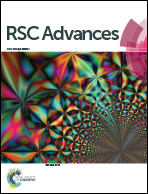A MnO2–[Ru(dpp)3]Cl2 system for colorimetric and fluorimetric dual-readout detection of H2O2
Abstract
Two-dimensional (2D) MnO2 nanosheets were synthesized by a template-free and one-step route, and the dye [Ru(dpp)3]Cl2 was linked onto the MnO2 nanosheet surface via electrostatic interaction. The formed MnO2–[Ru(dpp)3]Cl2 hybrid was used for a dual optical detection for H2O2, an important reactive oxygen species (ROS). Upon addition of H2O2, the reaction of MnO2 with H2O2 results in the dissolution of MnO2 nanosheets and simultaneous generation of O2. The fading of the solution and simultaneous fluorescence change of [Ru(dpp)3]Cl2, sensitive to O2, enables colorimetric and fluorimetric dual-mode detection of H2O2. The dual-output assay in a single probe provides a good sensitivity with a detection limit of 0.18 μM H2O2. The dual-signal strategy can efficiently overcome the shortcoming of the single detection mode, and improve the detection accuracy by an additional correction of output signals from each other. Moreover, the successful determination of H2O2 in the serum samples demonstrates the potential applicability of the MnO2–[Ru(dpp)3]Cl2 based probe in biosensing and bioanalysis.
![Graphical abstract: A MnO2–[Ru(dpp)3]Cl2 system for colorimetric and fluorimetric dual-readout detection of H2O2](/en/Image/Get?imageInfo.ImageType=GA&imageInfo.ImageIdentifier.ManuscriptID=C9RA00799G&imageInfo.ImageIdentifier.Year=2019)


 Please wait while we load your content...
Please wait while we load your content...